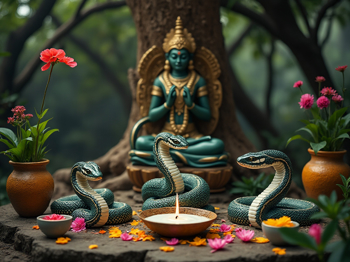The Nagula Chavithi puja is deeply rooted in the belief that snakes are sacred beings, associated with various deities in Hindu mythology, such as Lord Shiva and Lord Vishnu. The worship of Nagas is seen as a way to appease these powerful creatures and seek their blessings. The puja is also an expression of respect towards nature and its elements, recognizing the importance of maintaining harmony with all living beings. Performing the rituals on this day is believed to bring prosperity, fertility, and protection from evil.
- Protection from Snakebites: Worshiping the Nagas on this day is believed to provide protection from snakebites and other dangers associated with snakes.
- Health and Well-being: Devotees believe that observing the rituals and fasting can lead to good health and the prevention of skin-related diseases.
- Prosperity and Wealth: The blessings of the serpent deities are thought to bring prosperity, wealth, and material abundance to the household.
- Family Harmony: Women who perform the puja with devotion pray for the well-being and harmony of their families, fostering love and unity among family members.
- Spiritual Growth: Engaging in the rituals of Nagula Chavithi is seen as a way to cultivate spiritual discipline, devotion, and a sense of connection with the divine forces of nature.
- Protection of Children: Mothers especially pray for the long life and protection of their children, invoking the protective energies of the serpent deities.
Step-by-Step Procedure to Perform Nagula Chavithi
Observing Nagula Chavithi involves a series of rituals and steps, which are performed with devotion to seek the blessings of the Naga (serpent) deities. Here is a step-by-step guide to performing the puja:
1. Preparation and Fasting
- Fasting: Devotees typically observe a fast on Nagula Chavithi. The fast can be a complete fast (nirjala) or a partial fast where fruits and milk are consumed. The fast is maintained until the puja is completed.
- Bathing: Begin the day by taking an early morning bath, preferably using water mixed with a few drops of holy Ganga water if available.
- Clothing: Wear clean, traditional clothes after the bath. White or yellow clothes are often preferred, as they are considered auspicious.
2. Setting Up the Puja Space
- Puja Area: Choose a clean and quiet area in your home or near a snake pit (if accessible) for performing the puja.
- Kolam/Rangoli: Decorate the puja area with a traditional rangoli or kolam, often drawn with rice flour.
- Naga Idol or Image: Place a Naga idol, image, or a representation of a snake made from turmeric paste on a raised platform or on the ground.
3. Offering Items
- Puja Thali: Arrange a puja thali (plate) with items like turmeric, kumkum (vermilion), sandalwood paste, flowers (especially jasmine or marigold), betel leaves, betel nuts, fruits (especially bananas), coconuts, milk, and sweets (like jaggery or laddus).
- Naivedyam: Prepare offerings (naivedyam) such as payasam (kheer), milk, and other traditional foods to be offered to the deity.
4. Performing the Puja
- Lighting the Lamp: Begin the puja by lighting a ghee lamp and incense sticks.
- Invocation: Offer prayers to Lord Ganesha first to remove obstacles, then proceed with the Naga puja.
- Prayers and Mantras: Chant mantras dedicated to the Naga deities, such as "Om Namah Shivaya" or specific Naga mantras like "Naga Gayatri Mantra."
- Abhishekam (Anointing): Perform abhishekam (ritual bathing) of the Naga idol with milk, water, and turmeric.
- Offering Puja Items: Apply turmeric and kumkum to the idol or image, then offer flowers, betel leaves, fruits, and sweets.
- Naivedyam: Offer the prepared food to the deity, seeking blessings for the well-being of your family.
- Aarti: Perform aarti (circling of the lamp) while singing or reciting hymns dedicated to the Nagas.
5. Concluding the Puja
- Prayers for Protection: Conclude the puja by praying for protection from snakes, prosperity, and the well-being of your family.
- Circumambulation: If performing the puja near a snake pit, circumambulate the pit three times while praying. If at home, you can circle the idol or image.
- Distribution of Prasad: Distribute the prasad (the offerings made to the deity) to family members and neighbors.
6. Breaking the Fast
- Breaking the Fast: After completing the puja, the fast can be broken by consuming the prasad and other sattvic food.
7. Visit to a Temple
- Temple Visit: If possible, visit a nearby Naga temple or a Shiva temple to offer prayers and perform abhishekam to the Naga idol.
This step-by-step procedure is designed to be followed with devotion and sincerity, ensuring that the blessings of the Naga deities are invoked for protection, prosperity, and spiritual growth.
The Sarpa Gayatri Mantra is a sacred hymn dedicated to the serpent deities in Hinduism, often invoked for protection against snake-related fears, alleviation of astrological afflictions like Sarpa Dosha, and for seeking the blessings of the Nagas (serpent gods). Chanting this mantra with devotion is believed to bring peace, prosperity, and spiritual upliftment.
Sarpa Gayatri Mantra
Sanskrit (Devanagari):
ॐ सर्पाय विद्महे पद्महस्ताय धीमहि ।
तन्नः सर्पः प्रचोदयात् ॥
In English :
Om Sarpaya Vidmahe Padma Hastaya Dhimahi
Tanno Sarpah Prachodayat
Pronunciation Guide:
- Om: Aum
- Sarpaya: Sar-paa-ya
- Vidmahe: Vid-ma-hé
- Padma Hastaya: Pad-ma Has-taa-ya
- Dhimahi: Dhi-ma-hé
- Tanno: Tan-no
- Sarpah: Sar-pah
- Prachodayat: Pra-cho-da-yaat
Meaning of the Mantra
-
Om (ॐ): The primordial sound representing the universal consciousness.
-
Sarpaya Vidmahe (सर्पाय विद्महे): We meditate upon the Serpent God.
-
Padma Hastaya Dhimahi (पद्महस्ताय धीमहि): Who holds a lotus in his hand, let us contemplate that divine being.
-
Tanno Sarpah Prachodayat (तन्नः सर्पः प्रचोदयात्): May that Serpent God enlighten and guide us.
Significance and Usage
-
Alleviation of Sarpa Dosha:
- Sarpa Dosha is an astrological condition believed to be caused by the harm or killing of serpents in a past life. This dosha can manifest as obstacles in personal and professional life, especially concerning marriage and progeny. Regular chanting of the Sarpa Gayatri Mantra is believed to mitigate these adverse effects.
-
Protection Against Snake-related Afflictions:
- In regions where snakes are prevalent, invoking the serpent deities through this mantra is believed to offer protection against snake bites and other related dangers.
-
Spiritual Growth and Prosperity:
- Beyond addressing fears and astrological concerns, the mantra is also a means to seek general well-being, prosperity, and spiritual enlightenment.
-
Ritualistic Observances:
- Naga Panchami: A significant festival dedicated to serpent worship. Chanting the Sarpa Gayatri Mantra during this time is considered highly auspicious.
- Tuesday Worship: Given the association of Tuesdays with Mars (Mangala), which also governs aspects related to snakes in astrology, chanting on this day can be beneficial.
Recommended Practices
-
Chanting Frequency: It is customary to chant the mantra 108 times daily, using a japa mala (prayer beads) to keep count. The number 108 is considered sacred in Hinduism.
-
Best Time to Chant: Early morning during Brahma Muhurta (approximately 1.5 hours before sunrise) is considered the most conducive time for spiritual practices. However, one can also choose any time of the day based on convenience, ensuring the mind is calm and focused.
-
Purity and Devotion: Before chanting, it's advisable to take a bath and wear clean clothes. Sit in a quiet place, preferably facing east, and focus your mind on the divine form of the Serpent God.
-
Visualization: While chanting, visualize a serene image of the serpent deity, adorned with a lotus in hand, emanating protective and benevolent energies.
Additional Notes
-
Alternative Mantra Versions: While the above is a widely recognized version of the Sarpa Gayatri Mantra, there are other variations dedicated to specific serpent deities like Ananta, Vasuki, Takshaka, Karkotaka, and others.
-
Integration with Other Practices: Along with chanting, performing Sarpa Puja (serpent worship) at temples, offering milk to snake pits, or participating in community rituals can enhance the auspicious effects.
-
Consultation with Astrologers: If one is specifically addressing Sarpa Dosha or other astrological concerns, it's beneficial to consult with a knowledgeable astrologer to understand the comprehensive remedies.
By embracing the Sarpa Gayatri Mantra with sincere devotion and regular practice, devotees seek the grace and protection of the serpent deities, aiming for a life filled with harmony, prosperity, and spiritual fulfillment.




